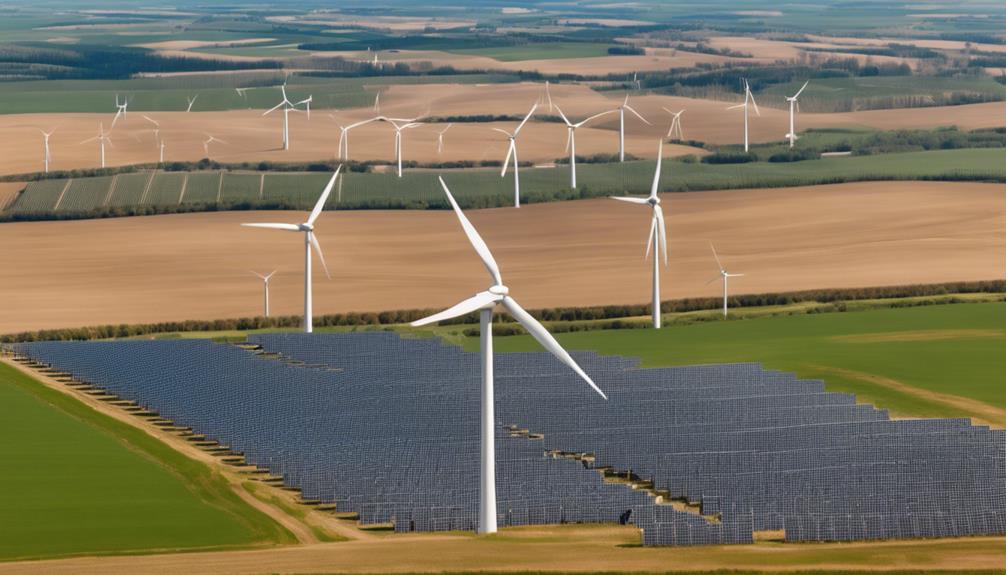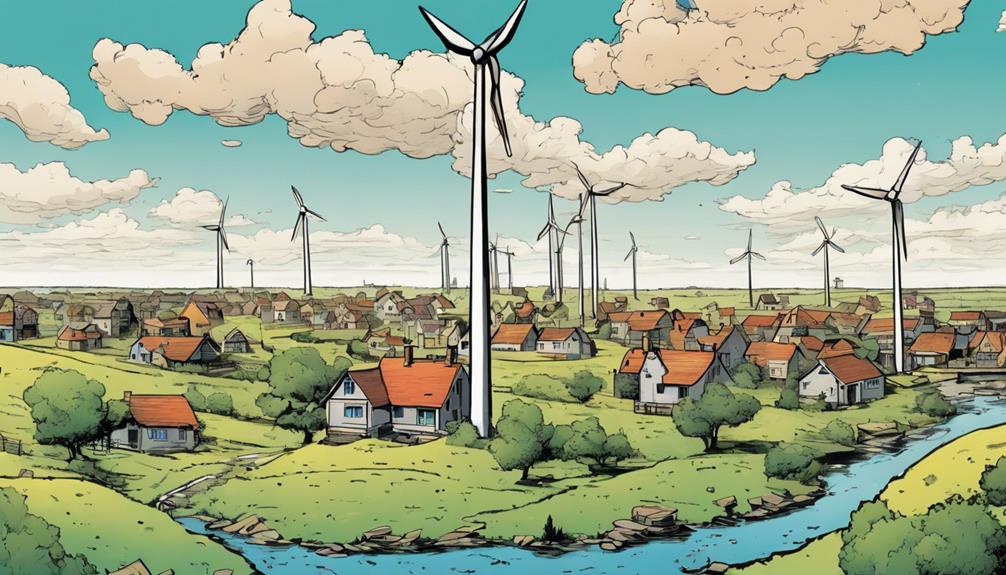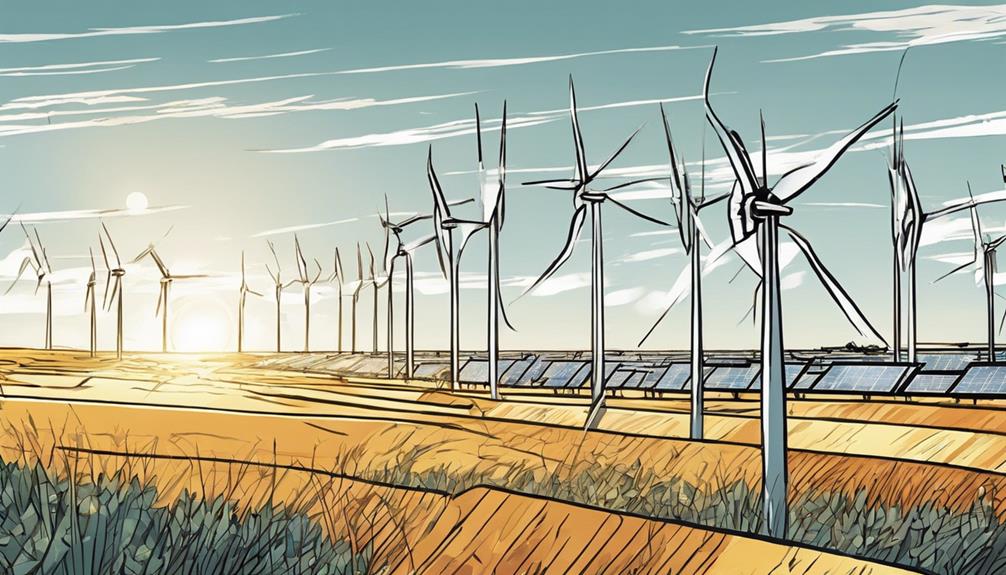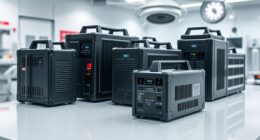When deciding between wind turbines and solar panels, note the varying costs, impacts, reliability, and efficiency. Solar panels offer lower upfront costs, emit fewer greenhouse gases, and need minimal upkeep. They can integrate well into diverse surfaces. Wind turbines, boasting high reliability rates, need regular maintenance but offer higher efficiency in consistent wind areas. Although wind turbines demand more upfront investment, they're cost-effective in regions with steady wind patterns. Understanding these differences can help you make an informed choice for your energy needs.
Key Takeaways
- Solar panels have lower upfront costs than wind turbines.
- Wind turbines are more reliable with a rate of over 98%.
- Wind turbines are more efficient in consistent wind areas.
- Initial investment for wind turbines can range from tens of thousands to millions.
- Solar panels have an efficiency rating of 15-25%, while wind turbines have an efficiency of 25-30%.
Solar Panel Costs and Impacts
Solar panels offer a cost-effective and environmentally friendly energy solution. The average cost of solar panels is approximately $2.19 per watt, making them a budget-friendly option for renewable energy. Compared to wind turbines, solar panels have lower upfront costs, making them more accessible for residential installations.
By harnessing solar power, these panels play an essential role in reducing greenhouse gas emissions and combating environmental degradation. Additionally, solar panels require minimal maintenance once installed, contributing to their cost-effectiveness. This sustainable energy source can be seamlessly integrated into various surfaces, maximizing energy production efficiency.
Whether on rooftops, building facades, or open fields, solar panels offer a versatile and reliable solution for generating clean energy. Embracing solar technology not only benefits the environment but also provides a sustainable and long-term energy solution for homes and businesses alike.
Wind Turbine Reliability Analysis
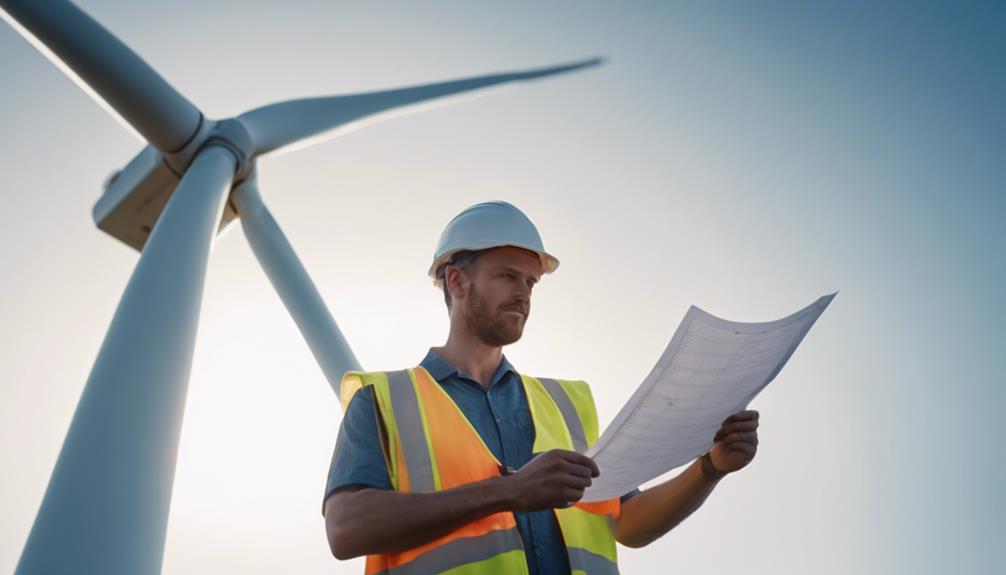
Maximizing the reliability of wind turbines is essential for maintaining consistent energy production in varying wind conditions. Modern wind turbines boast an impressive average reliability rate of over 98%, thanks to rigorous reliability testing that ensures they can withstand harsh weather conditions. Regular maintenance and monitoring play an important role in maximizing the lifespan and dependability of these turbines. Additionally, wind turbine manufacturers often offer warranties to guarantee their performance over time.
| Aspect | Description | Importance |
|---|---|---|
| Reliability Testing | Confirms turbines can withstand harsh conditions and operate efficiently. | High |
| Regular Maintenance | Essential for optimizing the lifespan and reliability of wind turbines. | High |
| Monitoring | Continuous monitoring helps detect issues early and prevent unexpected breakdowns. | Medium |
| Lifespan | Proper care and maintenance can significantly prolong the lifespan of wind turbines. | High |
| Warranties | Manufacturers' warranties provide assurance of reliability and performance over time. | High |
Efficiency of Solar Vs. Wind
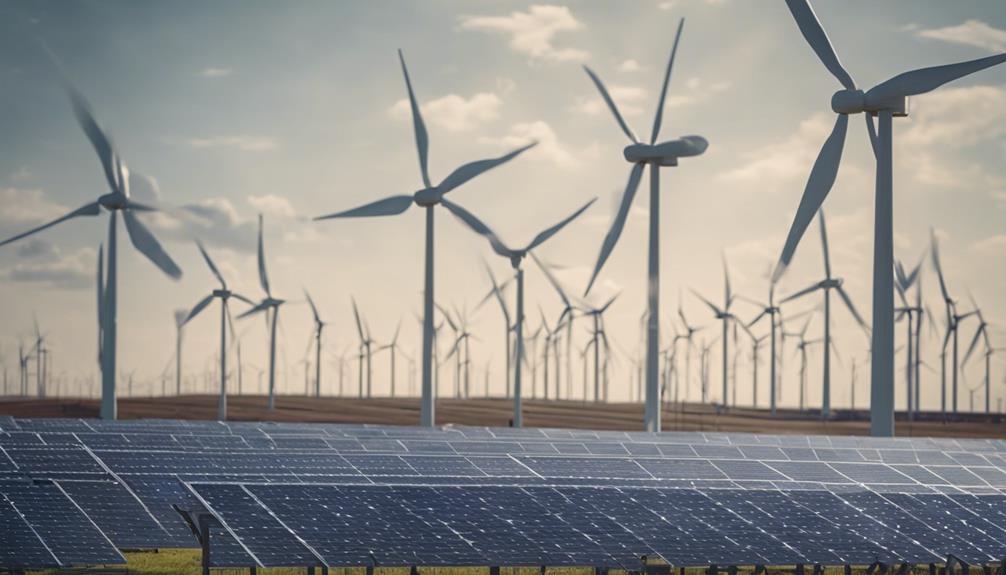
When comparing the efficiency of solar panels and wind turbines, one key factor to take into mind is their respective energy generation capabilities in various environmental conditions.
Here are some essential points to keep in mind:
- Solar panels typically have an efficiency rating of 15-25%, with advanced technologies reaching up to 40% efficiency.
- On the other hand, wind turbines have an average efficiency of around 25-30% in generating electricity.
- Wind turbines can be more efficient in harnessing wind energy when located in areas with consistent wind patterns.
- Solar panels are more reliable due to consistent sunlight availability, which contributes to their efficiency.
Both solar panels and wind turbines play significant roles in the renewable energy sector, with each having its advantages regarding efficiency. Understanding how these technologies perform under different conditions can help in making informed decisions when contemplating renewable energy options.
Environmental Impacts of Solar Energy
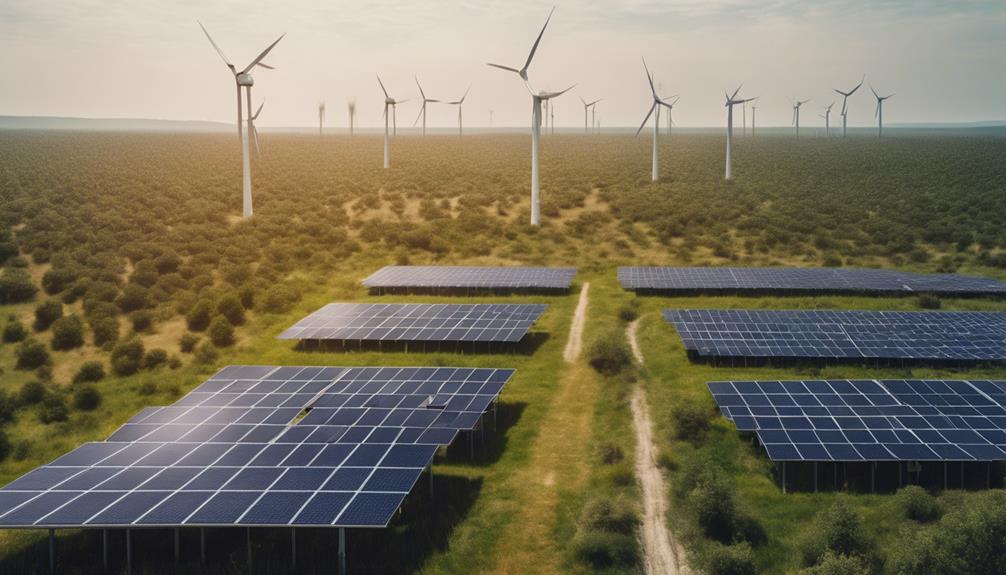
Solar energy offers significant benefits for the environment, such as reducing greenhouse gas emissions and promoting sustainability.
When considering wildlife conservation, solar panels provide a more wildlife-friendly option compared to other energy sources.
Additionally, the sustainable land use associated with solar installations helps preserve natural habitats and ecosystems.
Wildlife Conservation Considerations
Minimizing the impact on wildlife is a critical aspect of planning and implementing solar energy projects. When considering wildlife conservation in solar energy initiatives, here are some key points to keep in mind:
- Habitat Disruption: Ground-mounted arrays can lead to habitat disruption for various species, affecting their natural behaviors and interactions within ecosystems.
- Insect Attraction: The bright surfaces of solar panels can attract insects, potentially disrupting local ecosystems and food chains.
- Bird Collisions: Large-scale solar installations in bird migration pathways pose a risk of bird collisions with panels, highlighting the need for careful siting considerations.
- Conservation Efforts: Proper solar panel design and collaborative efforts between conservationists and developers are essential for mitigating wildlife impacts and promoting sustainable coexistence between solar energy projects and local fauna.
Sustainable Land Use
Utilizing rooftops, open fields, and other underutilized spaces, solar energy promotes sustainable land use practices by minimizing environmental impacts. Solar panels have a low environmental impact, emitting no greenhouse gases and requiring minimal land disruption. These systems can be seamlessly integrated into existing infrastructure, reducing the need for additional land use. Solar farms serve as a sustainable solution for generating electricity without contributing to deforestation or habitat destruction. The minimal environmental impact of solar energy makes it a valuable tool for promoting sustainable land use practices.
| Key Points | |
|---|---|
| Utilizes underutilized spaces | ✓ |
| Low environmental impact | ✓ |
| Integrated into infrastructure | ✓ |
| Minimizes habitat destruction | ✓ |
Wind Turbine Cost Comparison
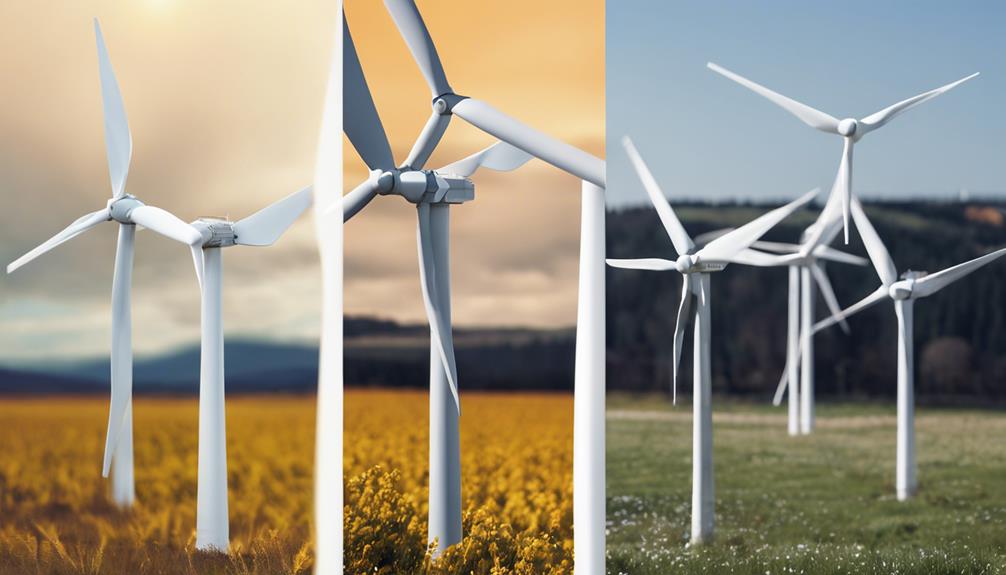
When thinking about wind turbines, it's important to recognize that their upfront costs are typically higher compared to solar panels. Here are some key points to keep in mind when comparing the cost of wind turbines:
- Cost Variability: The cost of wind turbines can vary significantly based on factors such as size, location, and installation requirements.
- Initial Investment Range: The upfront investment for a wind turbine system can range from tens of thousands to millions of dollars, depending on the specific project and turbine size.
- Operation and Maintenance: It's important to factor in ongoing operation and maintenance costs when evaluating the overall cost of wind turbines to guarantee long-term sustainability.
- Financial Incentives: Financial incentives and rebates may be available to help offset the initial installation costs of wind turbines, making them a more economically viable renewable energy option in the long run.
Taking these factors into account can provide a clearer understanding of the costs associated with wind turbine installations and their financial implications.
Solar Panel Reliability Assessment

Given the reliability of solar panels, it's worth mentioning that they typically come with a 25-year performance warranty, ensuring long-term efficiency and functionality. Solar panels are known for their dependability and require minimal upkeep once installed.
Regular professional cleaning is recommended to maintain peak performance and longevity. Unlike wind turbines, solar panels have no moving parts, resulting in silent operation, making them ideal for residential areas. This lack of moving parts contributes to their reliability, as there are fewer components that can wear out or malfunction.
Additionally, solar panels are a cost-effective energy solution with low maintenance requirements. Their durability and long-term performance warranty make them a reliable choice for generating electricity efficiently. When properly assessed and maintained, solar panels offer a stable and reliable source of renewable energy.
Economic Efficiency: Solar Vs. Wind
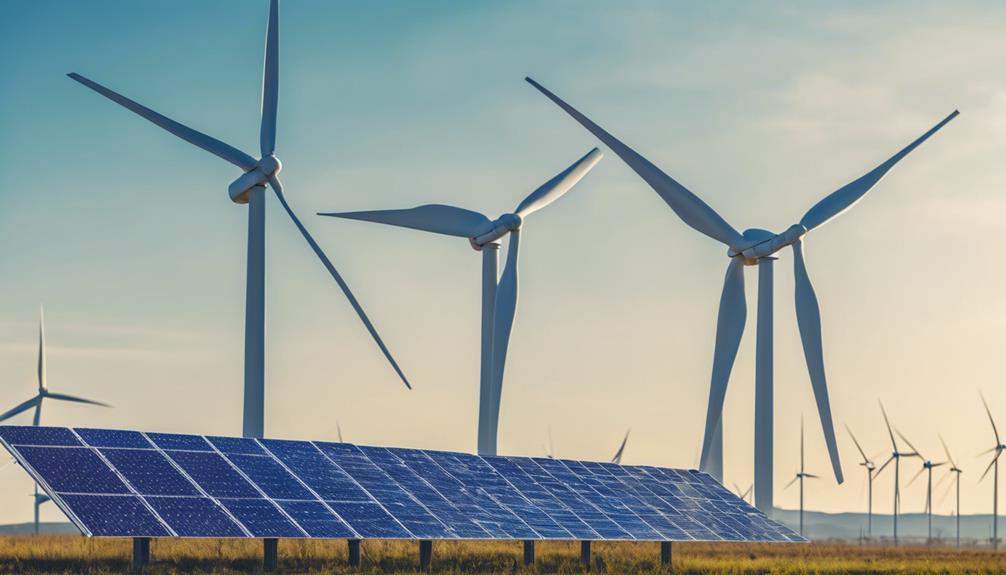
Comparing the economic efficiency of solar power and wind energy reveals distinct cost differences that impact their viability for renewable energy installations. When considering economic efficiency, initial investment plays an essential role in determining the affordability of each option.
Here are some key points to help you navigate the economic considerations between solar and wind energy:
- Solar power typically costs around $2.19 per watt, while wind energy comes in at approximately $1.50 per watt.
- The initial investment for wind turbines may be higher than solar panels, affecting economic viability.
- Solar panels are more cost-effective for residential installations compared to wind turbines.
- Wind energy can be more affordable in regions with consistent wind patterns, influencing economic considerations.
Both solar and wind energy sectors have benefited from technological advancements and economies of scale, leading to decreasing costs over time. Understanding these factors can help you determine which renewable energy source aligns best with your economic goals.
Environmental Implications: Wind Energy
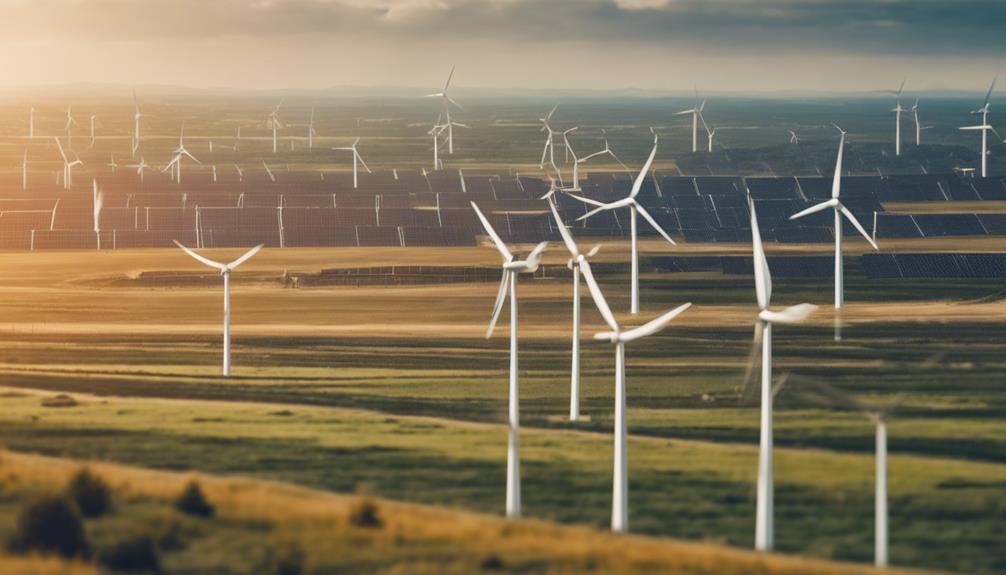
When considering the environmental implications of wind energy, it's important to address its impact on wildlife and land use efficiency.
Wind turbines have been known to pose a threat to birds and wildlife, but advancements in technology and proper siting can help mitigate these risks.
Additionally, optimizing land use for wind farms can contribute to reducing the overall environmental footprint of wind energy production.
Wildlife Impact Mitigation
Properly locating wind turbines and implementing effective technologies can greatly reduce the impact on wildlife. When examining the environmental implications of wind energy, mitigating wildlife impact is a key aspect that requires attention.
Here are some important points to take into account:
- Proper Siting: Selecting appropriate locations for wind turbines can help minimize the negative impact on wildlife habitats.
- Technology: Advancements in technology, such as using radar systems to detect birds and bats, can aid in reducing bird fatalities and other wildlife impacts.
- Bird Fatalities: While bird fatalities from wind turbines are relatively low compared to other human-related causes, continuous monitoring and research are essential to further minimize these occurrences.
- Environmental Concerns: Researchers are actively working on innovative solutions to address environmental concerns associated with wind energy, focusing on ways to harmonize renewable energy development with wildlife conservation efforts.
Land Use Efficiency
Wind turbines require significant land use due to their low land use efficiency, impacting local ecosystems and agriculture in the process. Onshore wind farms can occupy vast areas, potentially disrupting local ecosystems and agriculture. Offshore wind farms, on the other hand, offer a more efficient use of land compared to onshore installations.
The land requirements for wind turbines vary based on factors such as turbine size and spacing between turbines. Environmental assessments play an essential role in evaluating the land use implications when planning wind energy projects. By considering the impact on local ecosystems and agriculture, developers can make more informed decisions regarding the placement and design of wind turbines.
Balancing the need for renewable energy with the preservation of natural habitats and agricultural land remains a crucial aspect of sustainable wind energy development.
Frequently Asked Questions
Are Solar Panels More Cost Effective Than Wind Turbines?
Yes, solar panels are generally more cost-effective than wind turbines. They have lower upfront costs and maintenance expenses, making them a more affordable and accessible renewable energy option for homeowners looking to invest in sustainable energy solutions.
What Is More Reliable Wind or Solar Energy?
When considering reliability between wind and solar energy, you'll find solar energy shines bright. Solar panels offer a steady electricity source, even on cloudy days, while wind energy's consistency wavers with varying wind patterns.
How Many Solar Panels Equal One Wind Turbine?
To match the energy output of a 25 kW wind turbine, you would need about 271 solar panels. Wind turbines provide consistent energy day and night, while solar panels shine during daylight hours, offering a well-rounded energy mix.
What Is One Problem With Using Solar Panels or Wind Turbines to Produce Electricity?
When using solar panels or wind turbines to produce electricity, one snag you might encounter is their inconsistent performance due to factors like weather or wind patterns. This can lead to reduced efficiency.
How Do Bigger Wind Turbines Compare to Solar Panels in Terms of Efficiency and Impact?
Bigger wind turbine efficiency is a key factor in comparing them to solar panels. Wind turbines can generate more electricity in areas with consistent wind patterns, making them highly efficient. However, solar panels are easier to install and have minimal environmental impact, making them a more sustainable option in certain locations.
Conclusion
So, after all that comparing and contrasting, you might be surprised to find out that both wind turbines and solar panels have their pros and cons. Who'd have thought?
But hey, at least now you have a better idea of what factors to take into account when choosing between the two.
Just remember, when it comes to renewable energy, it's not always sunshine and rainbows – sometimes it's windy and cloudy too!
